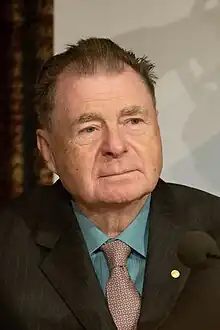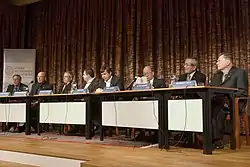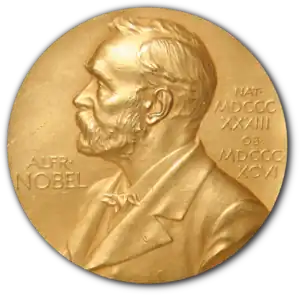Richard F. Heck | |
|---|---|
 Heck in 2010 | |
| Born | Richard Frederick Heck August 15, 1931 Springfield, Massachusetts, U.S. |
| Died | October 9, 2015 (aged 84) Manila, Philippines |
| Nationality | American |
| Alma mater | UCLA (BS, PhD) |
| Known for | Heck reaction |
| Spouse | Socorro Nardo-Heck (died 2012) |
| Awards | Glenn T. Seaborg Medal (2011) Nobel Prize in Chemistry (2010) |
| Scientific career | |
| Fields | Chemistry |
| Institutions | University of Delaware Hercules ETH Zurich De La Salle University |
| Doctoral advisor | Saul Winstein |
Richard Frederick Heck (August 15, 1931 – October 9, 2015) was an American chemist noted for the discovery and development of the Heck reaction, which uses palladium to catalyze organic chemical reactions that couple aryl halides with alkenes. The analgesic naproxen is an example of a compound that is prepared industrially using the Heck reaction.
For his work in palladium-catalyzed coupling reactions and organic synthesis, Heck was awarded the 2010 Nobel Prize in Chemistry, shared with the Japanese chemists Ei-ichi Negishi and Akira Suzuki.[1]
Early life and education
Heck was born in Springfield, Massachusetts in 1931.[2] He moved to Los Angeles when eight years old and later attended the University of California, Los Angeles (UCLA), gaining a bachelor's degree in 1952 and then a Ph.D. in 1954 working under the supervision of Saul Winstein on the chemistry of aryl sulfonates. After postdoctoral research at the ETH in Zurich, Switzerland with Vladimir Prelog, and then back at UCLA, Heck took a position with the Hercules Corporation in Wilmington, Delaware in 1956, working initially on polymer chemistry.[3]
Career

At Hercules, Heck soon became interested in organometallic chemistry, including work with David S. Breslow on organocobalt reactions.[4][5] This led to the development of the Heck reaction, which began with his investigation during the late 1960s of the coupling of arylmercury compounds with olefins using palladium as a catalyst.[3] This work was published in a series of seven consecutive articles in the Journal of the American Chemical Society for which Heck was the sole author.[6]
During the early 1970s, Tsutomu Mizoroki independently reported the use of the less toxic aryl halides as the coupling partner in the reaction.[7][8] Heck became a professor of chemistry at the University of Delaware's Department of Chemistry and Biochemistry in 1971, where he continued to improve the transformation, developing it into a powerful synthetic method for organic synthesis.[3]
The importance of this reaction grew as it was taken up by others in the organic synthesis community.[9][10] In 1982, Heck was able to write an Organic Reactions chapter that covered all the known instances in just 45 pages.[11] By 2002, applications had grown to the extent that the Organic Reactions chapter published that year, limited to intramolecular Heck reactions, covered 377 pages. These reactions, a small part of the total, couple two parts of the same molecule.[12] The reaction is now one of the most widely used methods for the creation of carbon-carbon bonds in the synthesis of organic chemicals. It has been subject to numerous scientific review articles, including a monograph dedicated to this subject published in 2009.[13]
Heck's contributions were not limited to the activation of halides by the oxidative addition of palladium. He was the first to fully characterize a π-allyl metal complex,[4] and the first to elucidate the mechanism of alkene hydroformylation.[5]
Palladium-catalyzed coupling reactions
Heck's work set the stage for a variety of other palladium-catalyzed coupling reactions, including those of aryl halides with derivatives of boronic acid (Suzuki–Miyaura coupling), organotin reagents (Stille coupling), organomagnesium compounds (Kumada-Corriu coupling), silanes (Hiyama coupling), and organozincs (Negishi coupling), as well as with amines (Buchwald–Hartwig amination) and alcohols.[14] These palladium-catalyzed coupling reactions are now widely practiced in organic synthesis, including for the manufacture of pharmaceutical drugs such as naproxen.[15]
Of the several reactions developed by Heck, the greatest societal impact has been from the palladium-catalyzed coupling of an alkyne with an aryl halide. This is the reaction that was used to couple fluorescent dyes to DNA bases, allowing the automation of DNA sequencing and the examination of the human genome; the reaction also allows biologically important proteins to be tracked.[16][17] In Sonogashira's original report of what is now known as the Sonogashira coupling, his group modified an alkyne coupling procedure previously reported by Heck, by adding a copper(I) salt.[18]
Later life and death
Heck retired from the University of Delaware in 1989, where he became the Willis F. Harrington Professor Emeritus in the Department of Chemistry and Biochemistry. Its annual lectureship was named in his honor in 2004. In 2005, he was awarded the Wallace H. Carothers Award, which recognizes creative applications of chemistry that have had substantial commercial impact. He was awarded the 2006 Herbert C. Brown Award for creative research in synthetic methods.[19][20] On October 6, 2010, the Swedish Royal Academy of Sciences awarded Heck the Nobel Prize in Chemistry, which he shared with Ei-ichi Negishi and Akira Suzuki "for palladium-catalyzed cross couplings in organic synthesis".[1][21][22] In 2011, Heck was awarded the Glenn T. Seaborg Medal for this work. In 2012, he was appointed by De La Salle University in Manila as an adjunct professor in its chemistry department. He had moved to Quezon City, Philippines after retirement, with his wife, Socorro Nardo-Heck. The couple had no children.[23][24]
Heck died on October 9, 2015, in Manila in a public hospital. His wife predeceased him by 2 years.[25][26]
Honorary degrees
Heck received honorary doctorates from the Faculty of Pharmacy at Uppsala University in 2011[27] and De La Salle University in 2012.[28]
References
- 1 2 Press release 6 October 2010, Royal Swedish Academy of Sciences, retrieved October 6, 2010
- ↑ Finucane, Martin (October 6, 2010). "Nobel Prize winner is Springfield native". Boston Globe.
- 1 2 3 Negishi, Ei-Ichi (1999). "A profile of Professor Richard F. Heck". Journal of Organometallic Chemistry. 576 (1–2): xv–xvi. doi:10.1016/S0022-328X(98)01136-X.
- 1 2 Heck, Richard F.; Breslow, David S. (1960). "Allylcobalt Carbonyls". Journal of the American Chemical Society. 82 (3): 750–751. doi:10.1021/ja01488a067.
- 1 2 Heck, Richard F.; Breslow, David S. (1961). "The Reaction of Cobalt Hydrotetracarbonyl with Olefins". Journal of the American Chemical Society. 83 (19): 4023–4027. doi:10.1021/ja01480a017.
- ↑ Heck, Richard F. (1968). "Acylation, methylation, and carboxyalkylation of olefins by Group VIII metal derivatives". Journal of the American Chemical Society. 90 (20): 5518–5526. doi:10.1021/ja01022a034. and six further articles, pages 5526–5548
- ↑ Mizoroki, Tsutomu; Mori, Kunio; Ozaki, Atsumu (1971). "Arylation of Olefin with Aryl Iodide Catalyzed by Palladium". Bulletin of the Chemical Society of Japan. 44 (2): 581. doi:10.1246/bcsj.44.581.
- ↑ Heck, R. F.; Nolley, J. P. (1972). "Palladium-catalyzed vinylic hydrogen substitution reactions with aryl, benzyl, and styryl halides". The Journal of Organic Chemistry. 37 (14): 2320–2322. doi:10.1021/jo00979a024.
- ↑ Beletskaya, Irina P.; Cheprakov, Andrei V. (2000). "The Heck Reaction as a Sharpening Stone of Palladium Catalysis". Chemical Reviews. 100 (8): 3009–3066. doi:10.1021/cr9903048. PMID 11749313.
- ↑ Mc Cartney, Dennis; Guiry, Patrick J. (2011). "The asymmetric Heck and related reactions". Chemical Society Reviews. 40 (10): 5122–5150. doi:10.1039/C1CS15101K. PMID 21677934.
- ↑ Heck, Richard F. (1982). "Palladium-Catalyzed Vinylation of Organic Halides". Organic Reactions. pp. 345–390. doi:10.1002/0471264180.or027.02. ISBN 0471264180.
- ↑ Link, J. T. (2002). "The Intramolecular Heck Reaction". Organic Reactions. pp. 157–561. doi:10.1002/0471264180.or060.02. ISBN 0471264180.
- ↑ Oestreich, Martin, ed. (2009). The Mizoroki-Heck Reaction. Chichester, United Kingdom: Wiley. pp. 1–608. ISBN 9780470033944. OCLC 233173519.
- ↑ Johansson Seechurn, Carin C. C.; Kitching, Matthew O.; Colacot, Thomas J.; Snieckus, Victor (2012). "Palladium-Catalyzed Cross-Coupling: A Historical Contextual Perspective to the 2010 Nobel Prize". Angewandte Chemie International Edition. 51 (21): 5062–5085. doi:10.1002/anie.201107017. PMID 22573393.
- ↑ Harrington, Peter J.; Lodewijk, Eric (1997). "Twenty Years of Naproxen Technology". Organic Process Research & Development. 1: 72–76. doi:10.1021/op960009e.
- ↑ Kodama, Koichiro; Fukuzawa, Seketsu; Nakayama, Hiroshi; Sakamoto, Kensaku; Kigawa, Takanori; Yabuki, Takashi; Matsuda, Natsuko; Shirouzu, Mikako; Takio, Koji; Yokoyama, Shigeyuki; Tachibana, Kazuo (2007). "Site-Specific Functionalization of Proteins by Organopalladium Reactions". ChemBioChem. 8 (2): 232–238. doi:10.1002/cbic.200600432. PMID 17195252. S2CID 46474691.
- ↑ Lim, Reyna K. V.; Li, Nan; Ramil, Carlo P.; Lin, Qing (2014). "Fast and Sequence-Specific Palladium-Mediated Cross-Coupling Reaction Identified from Phage Display". ACS Chemical Biology. 9 (9): 2139–2148. doi:10.1021/cb500443x. PMC 4168780. PMID 25025771.
- ↑ Sonogashira, Kenkichi; Tohda, Yasuo; Hagihara, Nobue (1975). "A convenient synthesis of acetylenes: Catalytic substitutions of acetylenic hydrogen with bromoalkenes, iodoarenes and bromopyridines". Tetrahedron Letters. 16 (50): 4467–4470. doi:10.1016/S0040-4039(00)91094-3.
- ↑ "Richard Heck, professor emeritus and Nobel laureate, dies". udel.edu. October 10, 2015. Retrieved August 22, 2022.
- ↑ "2006 ACS National Award Winners". C&EN. 84 (6): 34–38. February 6, 2006. Archived from the original on August 6, 2007..
- ↑ "Richard F. Heck – Interview". Nobelprize.org. October 7, 2010. Archived from the original on October 14, 2010. Retrieved October 7, 2010.
- ↑ "BBC News – Molecule building work wins Nobel". bbc.co.uk. October 6, 2010. Archived from the original on October 7, 2010. Retrieved October 6, 2010.
- ↑ Suarez, Larissa Mae (October 7, 2010). "US scientist residing in Philippines wins 2010 chemistry Nobel". GMANews.tv.
- ↑ Quismundo, Tarra. "He's the only Nobel winner living in RP". Inquirer.net. Archived from the original on October 10, 2010.
- ↑ Nicholas St. Fleur (October 15, 2015). "Richard F. Heck, Chemist Who Revolutionized Drug Development, Dies at 84". New York Times. Retrieved October 16, 2015.
- ↑ Francisco, Rosemarie (October 10, 2015). "Nobel laureate chemist Richard Heck, 84, dies in Manila". Reuters. Archived from the original on March 5, 2016. Retrieved August 22, 2022.
- ↑ "Honorary Doctors of the Faculty of Pharmacy". uu.se. Retrieved May 28, 2018.
- ↑ "Make Life Simple" Through Chemistry, Nobel Laureate Dr. Richard Heck's Goal"". nast.ph. Retrieved May 28, 2018.
See also
External links
- Department of Chemistry and Biochemistry at the University of Delaware
- Richard F. Heck on Nobelprize.org
